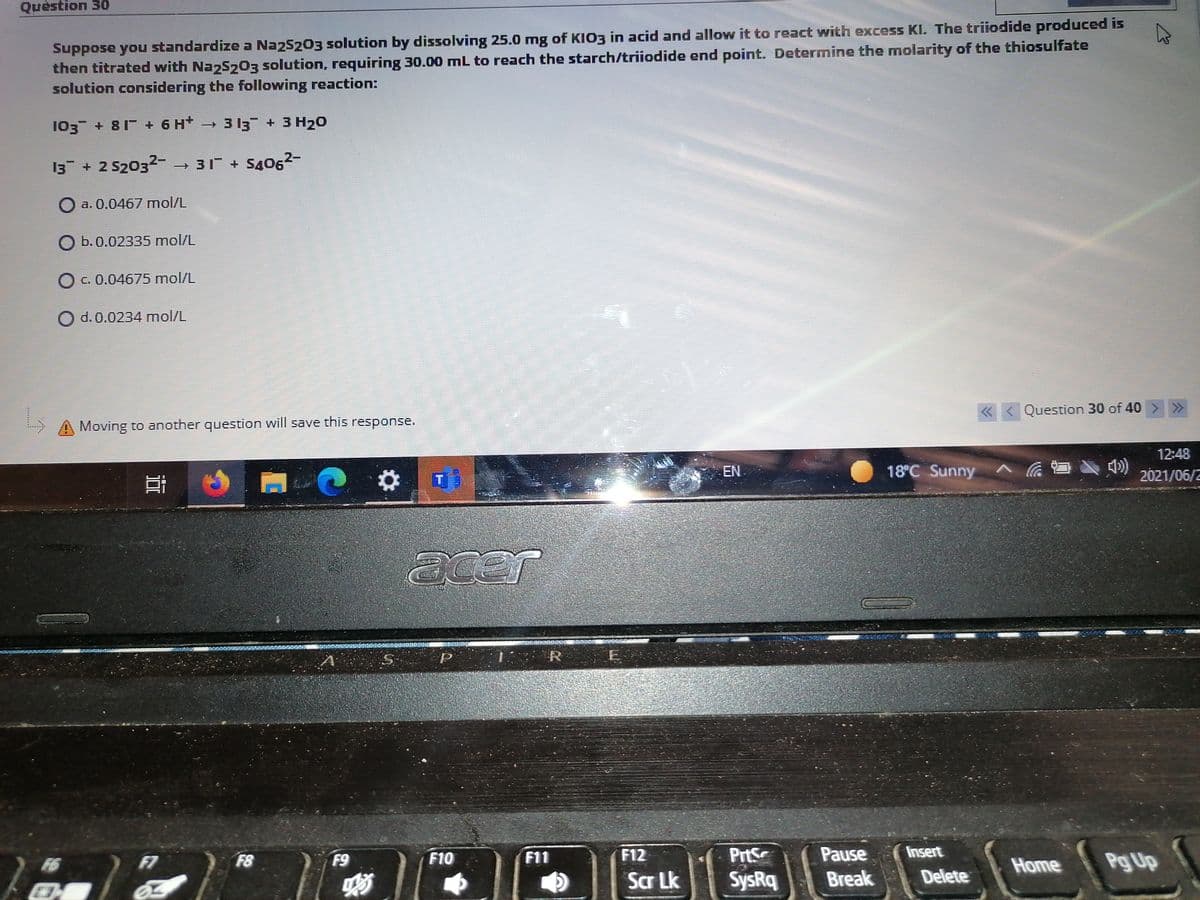Question 30 Suppose you standardize a Na25203 solution by dissolving 25.0 mg of KIO3 in acid and allow it to react with excess KI. The triiodide produced is then titrated with NazS203 solution, requiring 30.00 mL to reach the starch/triiodide end point. Determine the molarity of the thiosulfate solution considering the following reaction: 103 + 81 + 6 H* - 3 13 + 3 H20 13 + 2 S2032- - 31 + S4062- O a. 0.0467 mol/L O b.0.02335 mol/L O c. 0.04675 mol/L O d. 0.0234 mol/L A Moving to another question will save this response. « < Question 30 of 40 EN 18°C Sunny ) 202 近
Question 30 Suppose you standardize a Na25203 solution by dissolving 25.0 mg of KIO3 in acid and allow it to react with excess KI. The triiodide produced is then titrated with NazS203 solution, requiring 30.00 mL to reach the starch/triiodide end point. Determine the molarity of the thiosulfate solution considering the following reaction: 103 + 81 + 6 H* - 3 13 + 3 H20 13 + 2 S2032- - 31 + S4062- O a. 0.0467 mol/L O b.0.02335 mol/L O c. 0.04675 mol/L O d. 0.0234 mol/L A Moving to another question will save this response. « < Question 30 of 40 EN 18°C Sunny ) 202 近
Chemistry
10th Edition
ISBN:9781305957404
Author:Steven S. Zumdahl, Susan A. Zumdahl, Donald J. DeCoste
Publisher:Steven S. Zumdahl, Susan A. Zumdahl, Donald J. DeCoste
Chapter1: Chemical Foundations
Section: Chapter Questions
Problem 1RQ: Define and explain the differences between the following terms. a. law and theory b. theory and...
Related questions
Question

Transcribed Image Text:Quèstion 30
Suppose you standardize a Na25203 solution by dissolving 25.0 mg of KIO3 in acid and allow it to react with excess KI. The triiodide produced is
then titrated with Naz5203 solution, requiring 30.00 mL to reach the starch/triiodide end point. Determine the molarity of the thiosulfate
solution considering the following reaction:
103 + 81 + 6 H 3 13 + 3 H20
13 + 2 S2032-→ 31 + S4062-
O a. 0.0467 mol/L
b. 0.02335 mol/L
C. 0.04675 mol/L
O d. 0.0234 mol/L
« <
Question 30 of 40> >
Moving to another question will save this response.
12:48
EN
18°C Sunny
2021/06/2
acer
R
PrtS
Pause
Insert
Pg Up
F7
F8
F9
F10
F11
F12
Home
Scr Lk
SysRq
Break
Delete
Expert Solution
This question has been solved!
Explore an expertly crafted, step-by-step solution for a thorough understanding of key concepts.
This is a popular solution!
Trending now
This is a popular solution!
Step by step
Solved in 2 steps with 1 images

Knowledge Booster
Learn more about
Need a deep-dive on the concept behind this application? Look no further. Learn more about this topic, chemistry and related others by exploring similar questions and additional content below.Recommended textbooks for you

Chemistry
Chemistry
ISBN:
9781305957404
Author:
Steven S. Zumdahl, Susan A. Zumdahl, Donald J. DeCoste
Publisher:
Cengage Learning

Chemistry
Chemistry
ISBN:
9781259911156
Author:
Raymond Chang Dr., Jason Overby Professor
Publisher:
McGraw-Hill Education

Principles of Instrumental Analysis
Chemistry
ISBN:
9781305577213
Author:
Douglas A. Skoog, F. James Holler, Stanley R. Crouch
Publisher:
Cengage Learning

Chemistry
Chemistry
ISBN:
9781305957404
Author:
Steven S. Zumdahl, Susan A. Zumdahl, Donald J. DeCoste
Publisher:
Cengage Learning

Chemistry
Chemistry
ISBN:
9781259911156
Author:
Raymond Chang Dr., Jason Overby Professor
Publisher:
McGraw-Hill Education

Principles of Instrumental Analysis
Chemistry
ISBN:
9781305577213
Author:
Douglas A. Skoog, F. James Holler, Stanley R. Crouch
Publisher:
Cengage Learning

Organic Chemistry
Chemistry
ISBN:
9780078021558
Author:
Janice Gorzynski Smith Dr.
Publisher:
McGraw-Hill Education

Chemistry: Principles and Reactions
Chemistry
ISBN:
9781305079373
Author:
William L. Masterton, Cecile N. Hurley
Publisher:
Cengage Learning

Elementary Principles of Chemical Processes, Bind…
Chemistry
ISBN:
9781118431221
Author:
Richard M. Felder, Ronald W. Rousseau, Lisa G. Bullard
Publisher:
WILEY